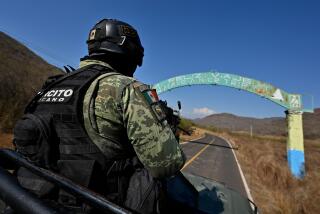A Hidden Enemy Lies in Wait on Afghan Soil
PESHAWAR, Pakistan — Masses of refugees on the move and American soldiers who may have to go to war face a hidden menace in Afghanistan: millions of buried land mines.
In the best of times, as many as 10 people step on mines in Afghanistan each day. However, as an estimated 1 million Afghans flee their homes, experts fear that many more people will be maimed or killed by weapons they can’t see.
“People moving, especially city dwellers, are heading into areas that are unfamiliar to them, so it is a very big risk,” Dan Kelly, who heads the United Nations’ Afghanistan Mine Action Center, said in an interview Wednesday.
Then-Soviet troops, their moujahedeen (Islamic holy warrior) enemies and Afghan armies fighting a civil war laid at least 6 million mines that are now waiting to explode, said Haji Attiqullah, whose Mine Clearance Planning Agency has mapped minefields across Afghanistan.
Small antipersonnel mines, often no bigger than a hockey puck, take the highest toll. They usually blow off limbs, often leaving the victim to die a slow, agonizing death. It can take several days to reach a hospital in Afghanistan, said Attiqullah, a former moujahedeen fighter who lost his right eye battling the Soviets during the 1980s.
Attiqullah, whose U.N.-funded agency shared the 1997 Nobel Peace Prize as part of the International Campaign to Ban Landmines, has videotape of an Afghan boy struggling to breathe his last breath after a mine blast mangled his body and charred his face beyond recognition.
The opposition Northern Alliance, whose efforts to drive the hard-line Taliban regime from power have gained U.S. support, has been laying minefields since 1996, Kelly said. The Taliban may be doing the same, he said.
But mine-clearing operations in Afghanistan have stopped since the Sept. 11 attacks on the U.S., as have relief and development efforts, so Kelly doesn’t know whether more of the devices are being laid to prepare for a new, wider war.
“I suspect there is going to be some” mine laying, said Kelly, a Canadian. “However, that hasn’t been confirmed. Over the period from 1995 to now, we have definite proof that the Northern Alliance has been laying mines. We have no conclusive proof for the Taliban.”
Attiqullah said he has asked the Russian government several times for maps of the minefields laid during the 10-year Soviet occupation, which ended in 1989. But he said Moscow insists that it will provide the information only to its Afghan ally, the Northern Alliance troops of deposed President Burhanuddin Rabbani.
The Taliban, which warns that it is arming tens of thousands of recruits to battle any U.S.-led force, has posted armed guards at some of the U.N.’s mine-clearing offices in Afghanistan, Kelly said.
Most of the Afghan minefields have been marked by red paint daubed on rocks by clearance crews to warn of the danger. Millions of Afghans have learned to watch for the warnings, but that is not nearly enough to stop the daily carnage, especially for desperate people walking in the dark.
The Afghan teams also were clearing battlefields littered with millions of unexploded mortar and artillery shells, rockets and bombs dropped during and after the Soviet occupation.
And as the threat of U.S.-led airstrikes grows, Afghan survey and clearance crews are training “for more kinds of munitions they have not been used to in the past,” Kelly said.
Only two of Afghanistan’s 30 provinces are free of land mines, which Kelly said contaminate about 891 million square yards of Afghan soil. That’s about 287 square miles of minefields.
But because the weapons are hidden underground, and no one knows how many new ones are being laid, virtually every footstep anywhere in Afghanistan can be risky.
Some of what lies in wait for fleeing refugees, or any soldiers who may find themselves in Afghanistan, is cataloged in the Mines Recognition Hand Book, which Attiqullah’s agency published in the mid-1990s.
It was out of date as soon as it left the printing press. Mine-clearing crews, or sappers, recently had been finding devices they had never seen in years of painstaking work, which usually is done with nothing more than an electronic minesweeper or sniffer dogs, a helmet and face mask, and a Russian-made bayonet to gently dig out the mine.
The book lists about 30 types of mines found in Afghanistan, including those left by the Soviets or provided by other countries to the moujahedeen.
They include mines from Britain, Belgium, China and Pakistan, Attiqullah said. A particularly nasty type was manufactured in Italy. It is known as a “bounding frag,” because when someone trips it, the mine jumps into the air before exploding and spraying bits of hot, jagged shrapnel.
An adult soldier would bear the brunt of the blast in his waist, which would not necessarily kill him. Most antipersonnel mines are designed to wound a soldier so that several of his comrades stop fighting to take him to a hospital.
Medical care is so hard to find amid the ruins of Afghanistan that nearly half of minefield victims die where they fall or before they reach medical help, Kelly said.
About 15% of Afghan mine victims are children, he added. A mine made to blast shrapnel into an adult’s waist would explode in a walking child’s face.
The number of verifiable victims in Afghanistan is about 150 a month. But that number is based on hospital reports, so the total including the dead who couldn’t reach a doctor is closer to 300, Kelly said.
During a decade-plus of work in Afghanistan, sappers have meticulously located and removed more than 10,000 antitank mines, 221,000 antipersonnel mines and 1.4 million pieces of unexploded ordnance, such as bombs and artillery shells, according to United Nations figures.
Britain’s late Princess Diana and the Nobel Prize-winning anti-mine campaign helped boost the budget for programs working to rid Afghanistan and other nations of the weapons. But donations were spread among 40 countries, Kelly said.
From 1997 to 1999, donors provided about $25 million a year for clearing mines in Afghanistan. The U.N. asked contributors for $20 million this year, and so far it has received only $11.5 million, he said.
Because of the shortfall, mine-clearing agencies had to lay off about 300 of 4,800 staff members. Most were Afghans working in the field for about $100 a month, often supporting extended families of 30 people.
The risks outweighed the cash rewards. At least 59 sappers have died in Afghan minefields since 1990, and 548 were injured.
The donors who pay sapper salaries simply have too many other demands to keep paying so many of them, Kelly said.
“The donor interest is still there,” he said. “It’s just that we built a program in the ‘97-to-’99 period that is very difficult to sustain in today’s world.
“On top of the mine problem, there are many other problems in Afghanistan--like just keeping people alive by providing food and shelter for them,” he said.
More to Read
Sign up for Essential California
The most important California stories and recommendations in your inbox every morning.
You may occasionally receive promotional content from the Los Angeles Times.










